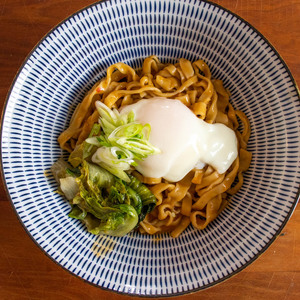Ingredients
Equipment
Method
- In a medium mixing bowl, combine the bean cooking liquid (or stock), fermented bean paste, sesame oil, and rice vinegar. Whisk until thoroughly combined and smooth. Season with kosher salt to taste.
- Cook the ramen noodles according to package directions in a large pot of boiling water until al dente.
- While noodles cook, divide the prepared sauce mixture evenly among four serving bowls.
- Drain the cooked ramen noodles thoroughly and immediately add them to the serving bowls with the sauce.
- Toss the noodles vigorously with the sauce until every strand is well coated.
- Divide the cooked beans evenly among the bowls, scattering them over the noodles.
- Garnish each bowl generously with sliced scallions.
- Carefully place one onsen egg on top of the noodles in each bowl.
- Serve immediately, allowing guests to break the egg yolk and mix it into the noodles for extra richness.
Notes
The quality of your fermented bean paste (doubanjiang, miso, gochujang) is paramount; it forms the backbone of the dish's umami. For the best texture, opt for fresh ramen noodles if available. When preparing the sauce, ensure a smooth emulsion to evenly coat the noodles. The bean cooking liquid adds a unique depth, but a good quality stock works well too. The onsen egg is crucial for richness, providing a creamy element that binds the flavors. Don't overcook the noodles; they should be al dente as they will absorb some of the sauce. This dish thrives on its simplicity and the balance of savory, aromatic, and slightly tangy notes.
